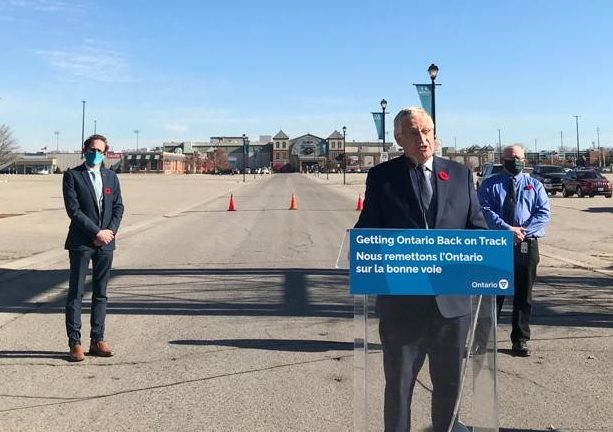Ontario’s agricultural and horticultural societies are getting a $5-million boost from the province to counterbalance revenue lost as a result of fall fairs being cancelled due to the coronavirus pandemic.

The news was announced Monday by Ernie Hardeman, the province’s minister of agriculture, food and rural affairs and Oxford MPP, during an outdoor news conference at the gate of the Western Fair District.
The one-time funding earmarked for the societies comes as part of Ontario’s 2020 budget, unveiled last week, and is in addition to other measures taken to help the sector, the province says.
Hardeman said the money will help support the organizations to continue operating and contributing to Ontario’s economic recovery during the pandemic.
“Our agricultural and horticultural organizations play a vital role in communities across rural Ontario. We want to preserve the rich tradition of fall fairs, exhibitions and activities that are key to rural economies and a mainstay of rural life in this province,” he said.
The heads of both the Ontario Association of Agricultural Societies (OAAS) and the Ontario Horticultural Association (OHA) lauded the news, saying the cash infusion will be of great help to their respective members, who have been hit hard by the pandemic.
To be eligible for the funding, agricultural and horticultural societies must demonstrate financial hardship, the province says.

Get daily National news
“This investment shows the confidence and appreciation they have for agricultural societies and their impact in Ontario, especially during these challenging times,” said Vince Brennan, manager of OAAS, which represents more than 200 agricultural societies.

According to the OAAS website, of the more than 200 fairs its member societies had been set to hold between June and October, nearly all were either cancelled or postponed. A small number, including the Western Fair, chose to hold events virtually instead.
“This funding will undoubtedly help inspire and support our agricultural societies in their communities and rural way of life,” he said.
The Canadian Association of Fairs and Exhibitions says the more than 740 falls and exhibitions it represents, including Toronto’s Canadian National Exhibition, provide up to $2.9 billion in overall economic impact.
In a separate statement, OHA president Katharine Smyth said the funding comes as many of its 27,000 members have been voicing concerns over their future.
“This announcement will help greatly in setting their minds at ease,” she said.
The OHA, which represents more than 280 horticultural societies across Ontario, is described by the province as a “volunteer charitable organization that encourages interest in gardening and related environmental issues.”
The $5 million in funding comes months after the province announced in August that it would provide up to $1 million to individual agricultural and horticultural societies hit by the pandemic through the loosening of grant eligibility requirements.
The one-time change made it so that agricultural and horticultural societies could still receive their annual grant despite not holding a fall exhibition or fair due to the pandemic, as required.
“The COVID-19 restrictions have prevented the events that would help to meet this criteria in 2020, with some societies at risk of closing their organizations without this support,” Hardeman said at the time.
In its first budget since the start of the pandemic, the province announced on Thursday that it will spend a record $187 billion this year as it lays out a plan to recover from the global health crisis.
The province will spend $45 billion over the next three years to respond to the pandemic, and will post a record deficit of $38.5 billion for this year, consistent with the government’s summer projections.
A path to balance is expected in next year’s budget, the province says.
— With files from The Canadian Press and Greg Davis of Global News












Comments